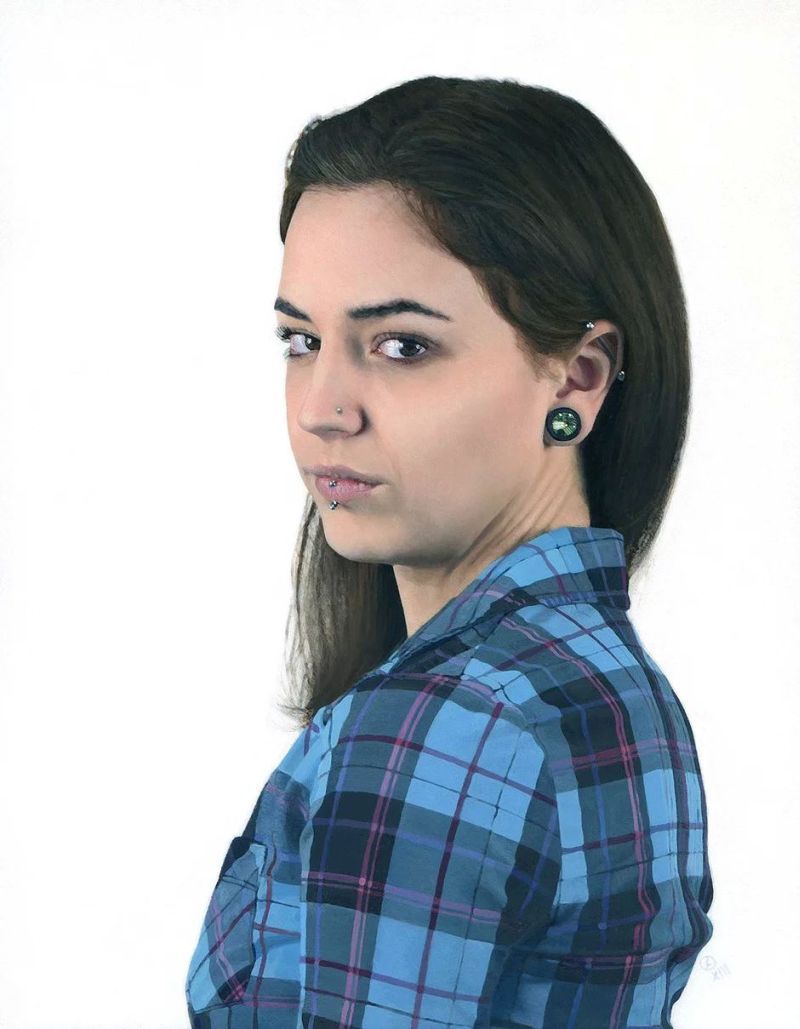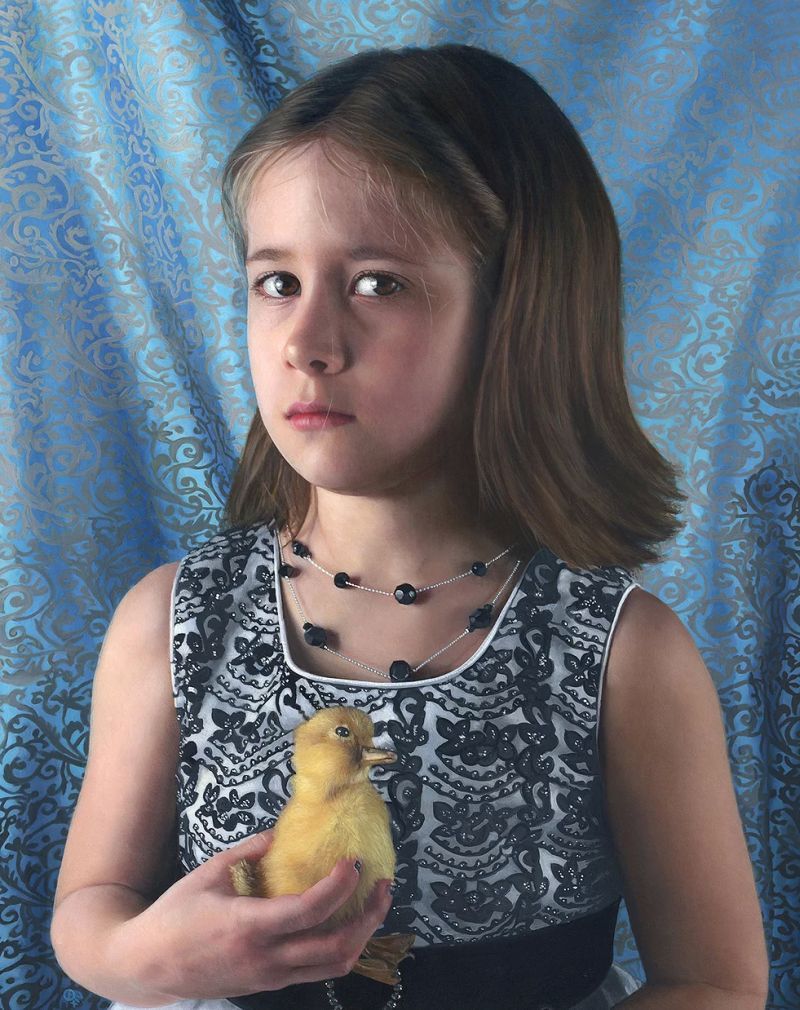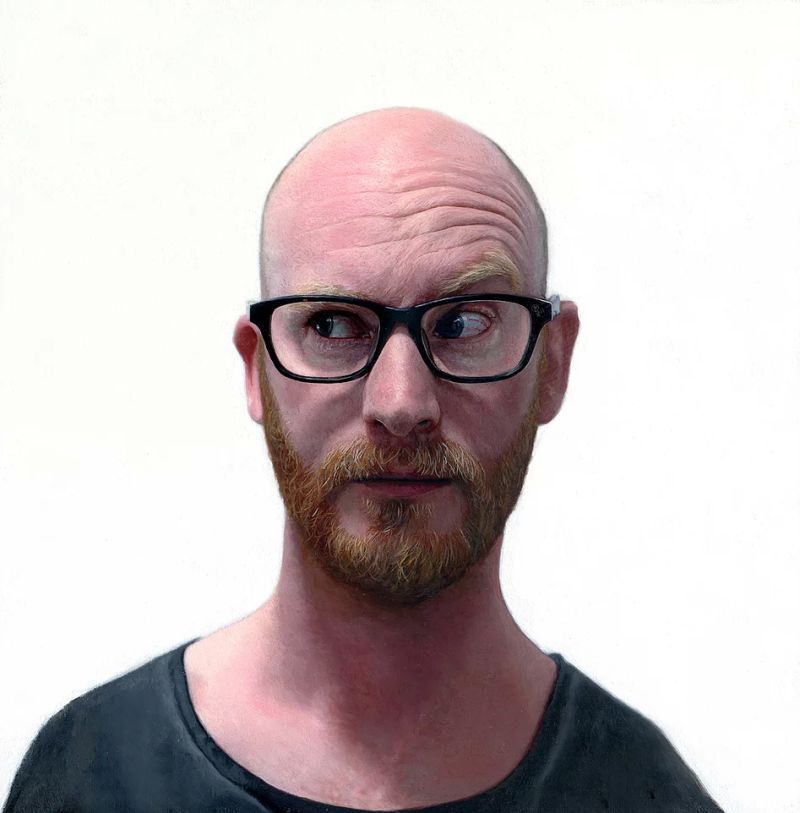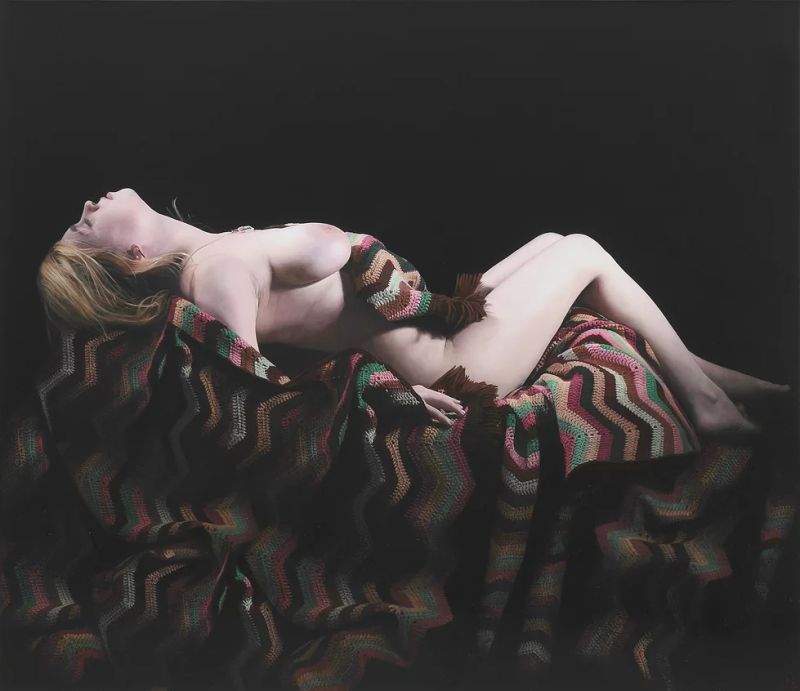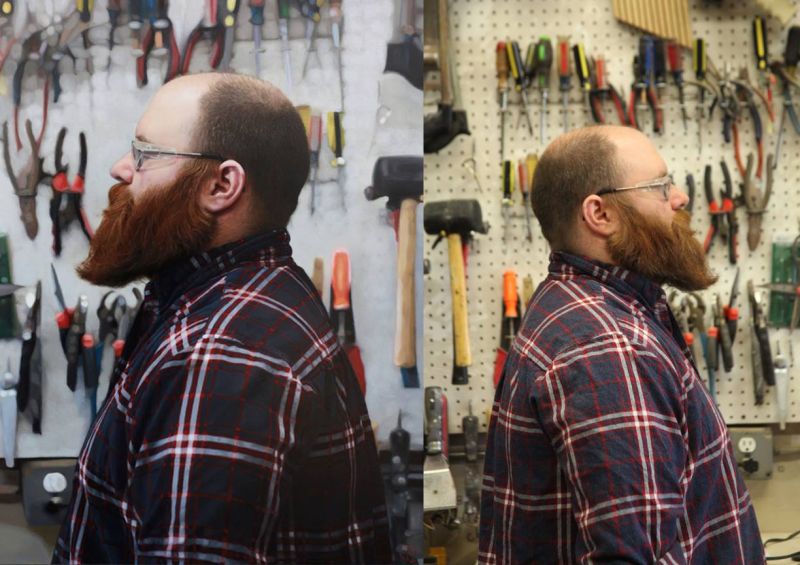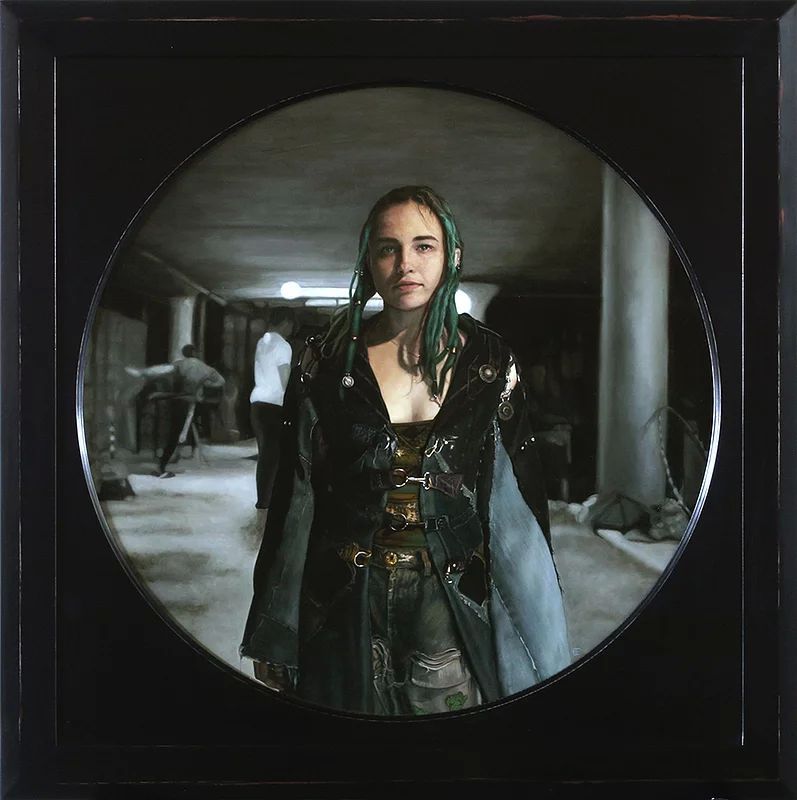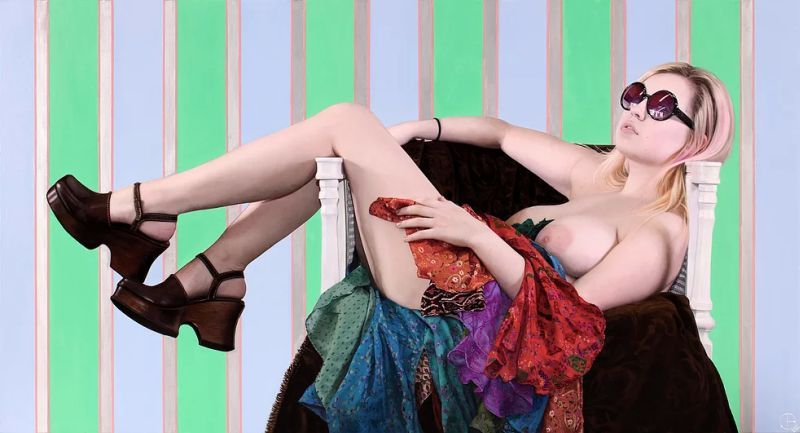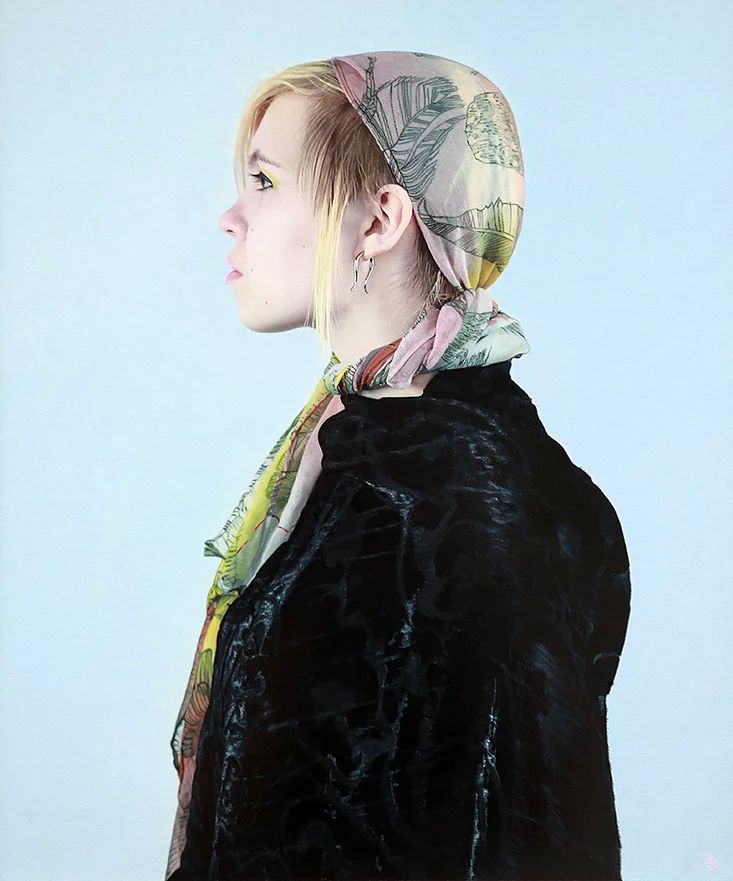David Eichenberg
"Devan", óleo sobre panel / oil on panel, 8,25" x 10,25" © David J. Eichenberg
"Aimee", óleo sobre panel / oil on panel, 6" x 7"© David J. Eichenberg
Fuentes / Sources:
* Website
* Revista Poetas y artistas / Poets and Artists Magazine
Kloosterboer sobre / on Eichenberg, por / by Lorena Kloosterboer, Feb., 2017
* Entrevista en Revista Poetas y artistas / Interview in Poets and Artists Magazine, Edición / Issue #51, 2013
* Belleza poco común / Uncommon Beauty, LAB, Edición / Issue #4
David Eichenberg es un artista estadounidense nacido en 1972 en Ohio, donde actualmente vive y trabaja.
Tiene una Licenciatura en Bellas Artes de la Universidad de Toledo, Ohio, 1998, especialización en escultura con Thomas Lingeman, y graduado en pintura con Linda Ames-Bell.
Ha mostrado su obra en varias exposiciones individuales y colectivas desde 1999, y recibió varios premios y honores en Estados Unidos, el Reino Unido y España.
«Cuando era estudiante en la universidad, recuerdo haber tenido conversaciones sobre arte figurativo y recuerdo cuántos de mis compañeros pensaron que estaba muerto. Siempre pensé lo contrario y vi signos en el mundo del arte de que en realidad estaba experimentando un renacimiento. Siento que estoy bien posicionado ahora y que con suerte puedo hacer algunas contribuciones significativas a este renovado interés en el género. También me encanta la extrema diversidad de la escena artística actual. No hay ningún arte que actualmente esté recibiendo atención que no me guste. Como pintor figurativo, no limito mis intereses sólo a ese rincón de la escena artística ».
"Aimee en azul / Aimee in Blue", óleo sobre panel / oil on panel, 7" x 9" © David J. Eichenberg
"Birdie y pato / and Duck"
Óleo sobre panel de aluminio / oil on aluminium panel, 9,5" x 12" © David J. Eichenberg
«Siempre me esfuerzo por avanzar no solo con mi trabajo, sino también con mi comprensión del mundo que me rodea. Aunque es con mi obra que espero compartir la belleza de las personas a las que encuentro a diario. Las personas que elijo como modelos son personas que parecen vestirse por fuera. Ya sea a través de adornos corporales, tatuajes o simplemente por la forma en que eligen peinar su cabello. Mi objetivo no es solo compartir con otros mis encuentros personales con estos modelos, sino también crear un registro histórico de la gran variedad de belleza que se puede encontrar a comienzos del siglo XXI. Estas son caras de personas que históricamente no se habrían considerado sujetos apropiados para el retrato.»
"Alan", óleo sobre panel / oil on panel, 6" x 6" © David J. Eichenberg
Eichenberg conoció a Alan Coulson, colega figurativo y retratista, en Londres. Fascinado por su pelo rojo y su aspecto idiosincrásico, Eichenberg tomó una instantánea de Coulson en un pasillo y luego pintó su retrato. Esta pieza destila habilidad técnica y un buen ojo para capturar la personalidad. Eichenberg afirma: "Esta es la pieza más compacta que he pintado". Los detalles son tan minuciosos, incluso la firma de monograma de Eichenberg que se encuentra en el borde de las gafas apenas se puede ver sin una lupa, teniendo en cuenta el tamaño de esta pieza. Eichenberg dice: "Una vez que sepas cómo manejar la técnica, tiene que haber más. Cómo incorporar ese algo extra para alcanzar un nuevo nivel es diferente en cada nueva pintura".
Eichenberg met Alan Coulson, fellow realist figure painter and portrait artist, in London. Fascinated by his red hair and idiosyncratic looks, Eichenberg took a snapshot of Coulson in a hallway and later painted his portrait. This piece exudes technical skill and a keen eye for capturing personality. Eichenberg states, “This is the tightest piece I’ve ever painted.” Details are so minute, even Eichenberg’s monogram signature found on the rim of the glasses can hardly be seen without a magnifying glass—note the size of this piece. Eichenberg says, “Once you know how to handle the technique, there has to be more. How to incorporate that something extra to reach a new level is different in each new painting.”
"Devan y colcha de punto / Devan and Afghan"
Óleo sobre panel de aluminio / oil on aluminium panel, 26" x 30"
"Aimee con pieles / Aimee in Fur", óleo sobre panel / oil on panel, 12" x 16" © David J. Eichenberg
«Veo estos retratos casi como los viejos grabados de Audubon. Son una herramienta y una forma para que las personas estudien el mundo que les rodea, dentro de sus propias zonas de confort y en su tiempo libre sin tener que involucrarse directamente con los sujetos. Al hacerlo, espero que sus experiencias y percepciones cambien en el mundo real, cuando se encuentren con personas que muestran adornos similares.
Utilizo fotos de referencias para mi trabajo. La mayoría de mis tomas de referencia son simples instantáneas rápidas. Sé que en el mundo del arte hay mucha resistencia, entre los pintores, al uso de la fotografía. La fotografía para mí es simplemente una herramienta que me permite registrar información relevante rápidamente, sin tener que cargar a mis modelos con tener que sentarse durante horas. Como puede tomar hasta 4 semanas terminar una pieza de 4 "x 6", fotografiar mis modelos es la única opción viable.»
"Doug", óleo sobre panel de aluminio / oil on aluminium panel, 10" x 13" © David J. Eichenberg
«Pensé que podría compartir un poco el "detrás de las escenas" de cómo trabajo. La imagen abajo muestra (a la derecha) la imagen original o instantánea (sin editar para su placer visual) que utilicé como referencia para la pintura de "Doug", a la izquierda. Como puede verse, hay muchas decisiones que deben tomarse antes de que se inicie una pintura, y esta fue una pieza bastante directa.»
«I thought I would share a little behind the scenes of how I work. The following image shows (on the right) the original image or snapshot (unedited for your viewing pleasure) that I used as a reference for the painting of "Doug" on the left. As you can see there are a lot of decisions that have to be made way before a painting is even started and this was a pretty straight forward piece.»
Izq./ Left: "Doug" - Der./ Right: Foto de referencia / Reference snapshot
"Grace", óleo sobre panel de aluminio / oil on aluminium panel, 12" x 12"
«Trabajo principalmente en óleo sobre panel compuesto de aluminio. Trabajar con óleos siempre ha sido mi preferencia. Me gusta la forma en que me dan tiempo de sobra para hacer cambios antes de fijarse. El uso de paneles de aluminio como sustrato ha requerido mucha experimentación. Hay muchos sustratos diferentes para elegir. Me decidí por los paneles de aluminio compuesto porque no se deforman ni se degradan y puedo lograr una superficie extremadamente lisa para pintar. La más mínima textura de superficie en mi sustrato crea sombras diminutas en la superficie que pueden alterar cómo se perciben mis representaciones. Considero que la textura de la superficie es una herramienta útil si se aplica donde es necesario, pero también una distracción donde no se desea, como con los patrones de tejido del lienzo o el lino.»
"Aimee con sudadera de capucha III / Aimee in Hoodie III"
Óleo sobre panel / oil on panel, 30" x 40" © David J. Eichenberg
"Hule / Rubber", óleo sobre panel de aluminio / oil on aluminium panel, 66 x 76,25 cm.
Todo en esta pintura tiene un significado. El piso de tablero de ajedrez evoca iglesias europeas que simbolizan la continua influencia del dogma religioso en nuestro pensamiento actual. Contrasta marcadamente con la pared verde y plana, un color que Eichenberg describe como un "verde institucional" que recuerda a los muros de la vieja escuela y a los ambientes regimentados similares a la prisión. Es el color de las narrativas falsas y las reglas duras que representan "cómo deben ser las cosas". La cómoda blanca no solo equilibra la composición descentrada, sino que está desgastada y astillada, simbolizando la idea de que uno debería avergonzarse del cuerpo y que el sexo no es por placer. Es una metáfora de la reprimenda de la sociedad para cubrirnos y esconder nuestro ser más íntimo. Esta pintura explora las costumbres sexuales de una manera confrontacional pero novedosa.
Mirando las figuras despersonalizadas no vemos ningún acto sexual, ninguna erección, ningún erotismo curvilíneo, ningún placer carnal, ningún gesto lascivo. Aunque su postura incómoda y tensa todavía logra sugerir una sensación de compasión y amor, las figuras están vestidas con trajes de goma que reducen las sensaciones físicas, las desensibilizan unas a otras y las deshumanizan ante nosotros, los espectadores. El hombre usa una máscara de pelota inflable que refleja el halo del sufrimiento de Cristo de Pietà, un artilugio de privación sensorial que efectivamente lo vuelve sordo y ciego. La única piel desnuda visible (además de los agujeros de la boca y los ojos) es la mano de la mujer que acuna tiernamente y sostiene la cabeza del hombre. El único pezón visible es el vástago de la válvula en la parte superior de la campana del globo que se utiliza para inflarlo; otro símbolo sardónico de la naturaleza represiva de los sistemas de valores sociales en relación con la desnudez.
Everything in this painting has a meaning. The checkerboard floor is evocative of European churches symbolizing the continued influence of religious dogma in our current thinking. It contrasts starkly against the flat green wall, a color Eichenberg describes as “institutional green” reminiscent of old school walls and prison-like regimented environments. It is the color of false narratives and harsh rules representing “the way things have to be.” The white dresser not only balances the off-center composition but is distressed and chipped, symbolizing the idea that one should be ashamed of one’s body and that sex is not for pleasure. It is a metaphor for society’s dressing-down (pun intended) to cover ourselves up and hide away our innermost being. This painting explores sexual mores in a confrontational yet novel way.
Looking at the depersonalized figures we see no sexual act, no erection, no curvaceous eroticism, no carnal pleasure, no lewd gestures. Although their uncomfortable, strained pose still manages to suggests a sense of compassion and love, the figures are clad in constricting rubber suits that reduce physical sensations, desensitizing them from each other and dehumanizing them to us, the viewers. The male wears an inflatable ball mask hood mirroring the halo of Pietà’s suffering Christ, a sensory deprivation contraption that effectively renders him deaf and blind. The only visible bare skin (besides mouth and eye holes) is the woman’s hand that tenderly cradles and supports the man’s head. The only visible nipple is the valve stem on top of the balloon hood used to blow it up; another sardonic symbol for the repressive nature of societal value systems regarding nudity.
"Devan en blanco II / Devan in White"
Óleo sobre panel / oil on panel, 7" x 9" © David J. Eichenberg
"Tad", óleo sobre panel / oil on panel, 10,25 x 8,25" © David J. Eichenberg
David Eichenberg is an American artist born in 1972 in Ohio, where he currently lives and works.
He has a B.F.A. from the University of Toledo, Toledo, Ohio, 1998, Major in sculpture with Thomas Lingeman, and Minor in painting with Linda Ames-Bell.
He showed his work in a number of solo and collective exhibitions since 1999, and received several awards and honors in USA, UK and Spain.
«When I was a student back in college I remember having conversations about representational art and I remember how many of my fellow students thought it was dead. I always thought otherwise and saw signs in the art world that it was actually experiencing a rebirth of sorts. I feel like I am positioned nicely now and that hopefully I can make some meaningful contributions to renewed interest in genre. I also love the extreme diversity of the current art scene. There is not a whole of art that is currently getting attention that I don not like. As a represenational painter I do not limit my insterests to only that corner of the art scene.»
"Jade (El ensayo / The Rehearsal)", óleo sobre panel / oil on panel, 19" x 19" © David J. Eichenberg
"Devan y bandas / Devan and Stripes"
Óleo sobre panel de aluminio / oil on aluminium panel, 20" x 31,5"© David J. Eichenberg
A primera vista, "Devan y bandas" es una versión moderna de una Madonna caída o una adaptación contemporánea de "La gran odalisca" de Ingres. El realismo detallado se establece contra un fondo plano rayado indescriptible que muestra a una mujer semidesnuda voluptuosa recostada sensualmente en una silla. Sin embargo, las primeras impresiones son engañosas. La mujer mira de soslayo a través de lentes oscuros, una mirada desafiante e inquisitiva, que sugiere una historia subyacente. Quizás ella no es simplemente el objeto sexual que imaginamos.
Saber que Devan es una persona transgénero da vida a la narrativa esencial de esta pintura. Fue el deseo de la modelo ser representada como un ideal de feminidad, para, de alguna manera, desafiar o purgar las dificultades y el sufrimiento inimaginables que implica vivir dentro del cuerpo "equivocado". Devan, nacida mujer, se identifica como un hombre. Esta toma de conciencia rompe la barrera entre Devan y el espectador, que con suerte pasará de ver un objeto sexual a preguntarse qué tortuosas tragedias jugaron en una vida en la que sentirse fuera de lugar es una dolorosa realidad cotidiana desde la primera infancia. Esta pintura nos confronta con las formas en que percibimos y juzgamos a los demás y a nosotros mismos. Examina la tragedia de no ser visto por lo que realmente somos.
At first glance Devan & Stripes is a modern-day version of a fallen Madonna or a contemporary adaptation of Ingres’ La Grande Odalisque. Detailed realism is set against a nondescript flat striped background showing a voluptuous seminude woman sensually reclining in a chair. However, first impressions are deceptive. The woman’s sideways gaze through dark glasses—a stare both challenging and inquisitive—suggests there’s an underlying story. Perhaps she’s not merely the sexual object we imagine.
Knowing that Devan is a transgender person brings this painting’s essential narrative to life. It was the model’s wish to be depicted as an ideal of femininity, to somehow defy or purge the unimaginable hardships and suffering that living inside the ‘wrong’ body implies. Devan, born female, identifies as a male. This realization breaks down the barrier between Devan and the viewer, who will hopefully switch from seeing a sexual object to wondering what tortuous tragedies played in a life where feeling out of place is a painful daily reality since early childhood. This painting confronts us with the ways in which we perceive and judge others and ourselves. It examines the tragedy of not being seen for who we truly are.
"Devan con pañuelo III / Devan in Scarf III"
Óleo sobre panel de aluminio / oil on aluminium panel, 13" x 18"© David J. Eichenberg
"Tim II", óleo sobre panel / oil on panel, 13,25" x 13,25" © David J. Eichenberg
«I am always striving to move ahead not only with my work but in my understanding of the world around me. It is though my work that I hope to share the beauty of the people that I ecounter an a daily basis. The people that I choose as my subjects are peopel who seem to wear themselves on the outside. Be it through body adornment, tattoos or simply by the way they choose to style their hair. My goal is not only to share with others my personal encounters with these subjects but it is also to create a historical record of the wide variety of beauty that can be found at the beginning of the 21st century. These are faces of people that historically would not have been considered appropriate subjects for portraiture.»
"Brittany en azul / Brittany in Blue"
Óleo sobre panel de aluminio / oil on aluminium panel, 6" x 7"© David J. Eichenberg
«I view these portraits almost like the old Audubon prints. They are a tool and way for people to study the world around them, within their own comfort zones and at their leisure without having to engage the subjects directly. In doing so, I hope their experiences and perceptions will be changed in the real world, when they encounter people displaying similar adornment.
I do use photo references for my work. Most of my reference shots are simple quick snapshots. I know within the art world there is a lot of resistance, among painters, to the use of photography. Photography to me is simply a tool which allows me to record relevant information quickly, without having to burden my models /sitters with having to sit for hours. Since it can take up to 4 weeks to finish a 4” x 6” piece, photographing my subjects is the only viable option.»
"Fiona", óleo sobre panel / oil on panel, 11,25" x 11,25" © David J. Eichenberg
"Devan", óleo sobre panel / oil on panel, 8,25" x 10,25" © David J. Eichenberg
«I work primarily in oil on aluminium composite panel. Working in oil have always been my preference. I like the way in which they are forgiving and give me the plenty of time to make changes before they set. The use of aluminium panels as my substrate has required a lot of experimentation. There are a lot of different substrates to choose from . I settled on composite aluminium panels because they do not warp or degrade and I can achieve an extremely smooth surface to paint on. The slightest surface texture on my substrate creates minute shadows on the surface which can alter how my renderings are perceived. I find surface texture to be a useful tool if applied where needed but also a distraction where it is not wanted, such as with the weave patterns of canvas or linen.»
"Aimee", óleo sobre panel / oil on panel, 6" x 7"© David J. Eichenberg
Fuentes / Sources:
* Website
* Revista Poetas y artistas / Poets and Artists Magazine
Kloosterboer sobre / on Eichenberg, por / by Lorena Kloosterboer, Feb., 2017
* Entrevista en Revista Poetas y artistas / Interview in Poets and Artists Magazine, Edición / Issue #51, 2013
* Belleza poco común / Uncommon Beauty, LAB, Edición / Issue #4
Imágenes publicadas con autorización del artista (¡Muchas gracias, David!)
Images published here with artist's permission (Thanks a lot, David!)

Entrevista (inglés, sin subtítulos) / Interview: Toledo Alumni Magazine


